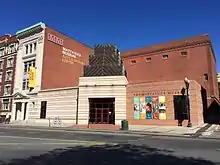Mattatuck Museum
The Mattatuck Museum is a cultural institution based in Waterbury, Connecticut, USA. The museum's displays include the history, industries and culture of Waterbury and the Central Naugatuck Valley area, and art, including works about the state's history, people and scenery, and works of artists from Connecticut. The museum also features a collection of 15,000 buttons from around the world.
 | |

| |
| Established | 1877 as The Mattatuck Historical Society |
|---|---|
| Location | 144 West Main Street, Waterbury, CT 06702 |
| Type | Art museum, history museum |
| Website | www.mattatuckmuseum.org |
Collection
The Mattatuck Museum focuses on the work of painters and sculptors who were born and/or based in Connecticut. Its collection spans the 18th, 19th and 20th centuries, and the artists represented in the museum's collection include Paolo Abbate, Abe Ajay, Alexander Calder, Frederic Church, Erastus Salisbury Field, Arshile Gorky, John Frederick Kensett, Peter Poskas, Kay Sage, Yves Tanguy and John Trumbull.[1]
The museum also highlights the commercial and cultural achievements related to the city of Waterbury. This includes a collection of 15,000 buttons, which was donated to the museum by the now-defunct Button Museum operated by the Waterbury Button Company.[2]
In 2008, the museum began offering self-guided tours of downtown Waterbury that highlight the city’s distinctive architectural achievements.[3] The museum also features a regional history exhibit that uses interactive displays, oral histories and historic movie clips to trace the past and present of Waterbury and the surrounding areas in New Haven County, Connecticut.[1]
The museum supports ongoing artistic achievement with its Connecticut Biennial, a competition that is open to artists who maintain a residence or a studio within the state. The biennial competition awards include products and gift certificates from local businesses.[4]
The remains of "Larry"
In 1999, the museum received national attention regarding one of its exhibits: the skeleton of a man that was discovered in 1910 in the boarded-up closet of a Waterbury building that was undergoing renovation. The skeleton was believed to date from the late 18th century and was dubbed "Larry," as that name was written on its skull. The skeleton was on display in a glass case until 1970, when it was removed from public viewing.[5]
However, a later investigation by the African-American Historic Project Committee determined the skeleton belonged to a black slave named Fortune who died in 1798. The museum created a special exhibit in honor of Fortune that detailed the lives of African-American slaves in the early part of the 19th century.[5]
References
- “Mattatuck Museum receives tourism grant,” Town Times, September 11, 2008 Archived June 8, 2011, at the Wayback Machine
- “More Than a Sewing Fancy,” New York Times, May 27, 2001
- ""Be a tourist in your own city," Waterbury Republican-American, August 9, 2008 (subscription access required)". Archived from the original on September 28, 2011. Retrieved September 17, 2008.
- “ART: When Artists Face Juries of Peers,” New York Times, November 26, 2000
- “Hidden Museum Treasures: Fortune's Bones 18th-Century Slave Gets New Life, New Recognition,” National Public Radio’s All Things Considered, September 16, 2003